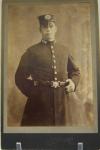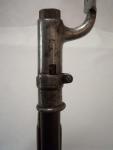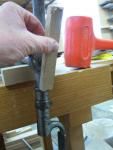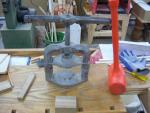-
Posts
6,486 -
Joined
-
Last visited
-
Days Won
10
Content Type
Profiles
Forums
Blogs
Gallery
Events
Store
Everything posted by Brian Wolfe
-
Hello John, When it comes to WWII Japanese swords the presentation, or surrender, swords are the top collectable. While there are a good deal of WWII Japanese swords available on the collector's market you don't see many with the engraved presentation plate. Very nice indeed. Thanks for posting them. Regards Brian
-

RAF Group
Brian Wolfe replied to erichjr's topic in Great Britain: Orders, Gallantry, Campaign Medals
I would not jump to conclusions based on any odd badges that come with a group. The tags do show RAF and the medals are not named so they are probably his and British. The trading of badges was common both during and after the war. My wife's uncle was in the Signals corps and the medals he had went to the Royal Canadian Lefion for display with the exception of his cap badges and collar badges which I now have along with a photo of him in uniform. In the box with the badges was a small assortment of other odds and ends of insignia and badges that my wife's aunte said he brought home from the Legion were other members gave them to him. If we were to guess his unit based on the medals and insignia it could have been any 9of a number of corps. As a general comment; many collectors will add hat badges to a group of medals, in this case in point, WWI medals, to make the collection look more attractive in the drawer or case. This is all well and good as WWI British Commonwealth Medals are all named and include the rank and corps. If you take this one step farther and to a photo of a WWII serviceman you add a group of medals that match the ribbon bar or the medals in the photo, if there are any shown, then add a hat badge etc. you have created something that is not really historically accurate, a nice display but not authentic. I am guilty of this myself, finding a nice photo of a soldier, British, Canadian, Imperial German or Japanese and because I have an exact group in the collection I add the photo to the drawer. I am sure that when I am gone and the collection sold this will be assumed to be the medals of the soldier in the photo. My bad. To be clear, I am not making any comment on the group originally shown in this post but rather making an observation that perhaps will generate some debate. Regards Brian -
If your looking for some older topics in the section regarding Japanese material please check the Japan Section as I have moved them. If you notice any that I have missed please contact me and I will take care of them. Many thanks to Nick (JapanX) for finding the ones I have moved and drawing them to my attention. Regards Brian
-
Please note that, thanks to JapanX, I have moved the topics regarding China to the correct section. If anyone sees more that need to be moved please contact me and I'll look after it. Regards Brian
-
No harm done, it was the reaction of a suspicious mind. too many years in enforcement I guess. I see from your photos that the blade has been stamped with the British double arrow mark indicating that the bayonet was sold off by the military. The fellow who brought it to your great great grandfather probably bought it from a surplus store with the intentions of having it made into the knife you mentioned. Your story of how your great great grand father came into possession of the bayonet is a very interesting one. At one time many people thought converted bayonets made good knives, sadly this is not the case as your great great grandfather was well aware. It's good, and lucky, that this bayonet has been kept intact and along with the story becomes a real family treasure. Sorry for the misconception, and thanks for taking the time to post the actual photos. Regards Brian
-
Hi Nick, We're just here to make your GMIC experience more enjoyable. Regards Brian
-
I just now read this tread and removed your double post. Regards Brian
-
I would be interested in knowing why, if this bayonet has been in your family for so many years it is also on ebay and closing in a few hours. http://www.ebay.ca/itm/190721668169?ssPageName=STRK:MEWAX:IT&_trksid=p3984.m1423.l2649 I have no problems answering questions about items for sale on eBay or anywhere else however I feel you may not have been quite above board with your post. Brian
-
This is the Artillery Carbine bayonet 2nd pattern, 1875 and made for the Martini-Henry Rifle. The first pattern (1875) had a 18 inch blade and the second pattern made in 1879 (which I would think this one is) had a blade 25 3/4 inches long. The handguard had a slot for a sword-knot as they were meant to serve as a sword and a bayonet. Reports state that they were not very useful as a sword. The teeth of these and any other British toothed bayonet patterns were removed in 1903 when the use of the saw-back bayonets were discontinued by the British. As to these being rare I can tell you that they have never been common even back 30 years. I don't talk price or values but I will say that these, while still availabe at most shows, are not nor ever were cheap. Shooting a carbine with one of these attached must have been difficult due to the excessive weight at the end of the barrel. Probably why they were in limited supply and eventually discontinued. As to the saw tooth myth. I had indeed read reports and articles were British soldiers in WWI would shoot any German found with a toothed bayonet, one report stated that the soldiers would cut the nose off anyone found with these. The Germans removed the teeth during the war but I don't believe because of the myth. As to pulling out the "guts" of anyone stuck with one of these, this is also propoganda ot urban myth. The saw teeth were pounting forward on the German bayonets and therefore could not catch on the intestines upon withdrawing the bayonet. When you think about it, who would design the teeth to disembowel someone? Getting a bayonet back out when it got stuck on a bone was bad enough but pulling out intestines would only hold the a soldier up getting his bayonet freed. I have never tried to cut wood with one of these, though I did own one. I did use a rusty old German butcher blade bayonet with saw teeth to try to cut a small tree limb and found it very difficult. I agree with Peter that this would end up casuing a lot of damage to the solider's hand in the form of blisters and perhaps even damage to the wrist (think of the angle of the hand to saw). Regards Brian
-
Hello and welcome to the forum. Nice bayonet and as soon as I get home I'll verify what I think this is and post my findings. Unless one of our keen members beats me to it, and they probably will. At this moment I think this is a pattern of Martini-Henry Artillery bayonet, however, I will verify that call. Regards Brian
-
Thank you for the correction Dave, I have made the changes to the original post. For those interested, what turned out to be a warrant card badge is quite flat, or thin, compaired with a standard cap badge. So as well as the points Dave makes being thinner is another clue to the identification. Dave, it looks as if there is little difference between the cap badge I posted in post #26, other than quality of material and the green backing, and the "ACPO" (Chief Officer). A collector looking for the higher rank cap badge should probably take these differences into consideration before handing over too much cash for what is being offered as a Chief Officer's cap badge. As many of us know at times accurate information is just not available to us and we count of the membership to point out errors when they encounter them. This allows the forum to be a good source of information to other collectors and I really appreciate this input. Thanks again Dave. Regards Brian
-
Today a friend of mine suggested that it may be a "horse brass" rather than a martingale badge. I'm not sure of the proper term but a horse brass is fastened to the harness to decorate it for parades etc. Regarding emigrants. I try not to get up set about them as eventually I'll look in a mirror and see yet another one and he looks just like me. Regards Brian
-
Hi Nick, The short answer to your question would have to be "no", it would have been a question in my mind as well because your date for a mounted unit was indeed 1919. I based my purchase of this item on two factors, neither of which proves the existance of mounted police prior to 1919. In the Staffordshire Police Commemoritive issue of their magazine in 1992 for their 150th anniversary there is a photo of a good sized collection of Staffoprdshire Police insignia. In this collection is a Victorian martingale badge, I looked very closely at the picture in this collection and it is so close to the one I have photographed as to have been it's twin. So I based it on an established collection to its existance and to the overall look. Of course this proves absolutely nothing other than this unknown collector and I have purchased a similar badge, authentic or not. I have been informed by a fellow collector and former Staffs PC that this particular collector had included in his collection, and therefore the photo in the magazine, several generic items that are common throughout the UK, such as an aluminum Special Constable brassard. Were there mounted officers for special duties, I don't know. Is this a a case where a collector pre 1992 and another (me) in 2013 fell prey to a maker of fanacy items? Possibly, however, up to this point I have not seen these on the market in any qualtity, though I don't profess to have my finger on the pulse of the collecting world. Regards Brian
-
I'm always happy when these older posts resurface from time to time as it not only puts them in the spot light for new members but also allows the older members to comment when they missed the original posts for some reason or another. When I say "older members" I am referring to the length of their membership and not life span, though that may be one and the same. I have had these in the collection in the past, some with markings and some with no markings. This was a very popular design in the early quarter of the 19th century and found wide acceptance throughout Europe. It is good to see one in a collection that can actually be traced to a particular country. A friend and fellow sword collector, who has sinced passed, used to say that these were great swords especially when unmarked as they would fit into any collection. In John Wilkinson Latham's book "British Military Swords", page 68 plate 66, he writes, "Foot Artillary Private's Hanger Circa 1814. This is a very common design of sword and was in use in practically every European army in the early part of the nineteenth century." In the case of the specimen in his book he states that the mark on his sword in undecipherable but may be "Trotter". I hope this adds some information to this interesting post. Regards Brian
-

Socket bayonet repairs Part 1
Brian Wolfe replied to Brian Wolfe's topic in Preservation & Restoration of Military Artifacts
Thanks Mervyn. It give me a good feeling to put artifacts back into servicable condition. Regards Brian -

Socket bayonet repairs Part 1
Brian Wolfe replied to Brian Wolfe's topic in Preservation & Restoration of Military Artifacts
Hi Peter, The Brown Bess usually had a rectangular stud on the top of the barrel where my specimen has a round post. This was used as a means to keep the bayonet on the musket though only one pattern that I know of, the one shown here, had a locking ring. Most Land Pattern sockets had only a Z sort of slot that allowed the bayonet to be turned there by preventitng the bayonet from being pulled off the barrel. I don't think the locking ring was developed until the 1853 Enfield Musket Rifle came into use. Though the Baker and Brunswick used a stud and locking device on their sword bayonets which predated the 1853. I have read that these Brown Bess bayonet posts were also used as a crude sight and I suspect that was also the point of their placement on the top of the barrel. As you know the Brown Bess was used during a time when massed volley at close range was all the rage. It was a matter of leveling your musket and fire. I will post this bayonet in the correct section later as the locking ring is not positioned in the same manner as every other socket bayonet I have encountered; it was one reason I decided to include it in the collection as my example of the Brown Bess bayonet. Regards Brian -

Socket bayonet repairs Part 1
Brian Wolfe replied to Brian Wolfe's topic in Preservation & Restoration of Military Artifacts
I didn't mentioned that I reversed the socket on the mandrill at the end of the process to assure the diameter was consistant throughout and this is shown in the photo below to the left. The right hand photo shows the bayonet mounted on the Brown Bess. Thanks for taking the time to follow this long post and good luck with your own restorations. Be sure to share them with the other members here on GMIC. Regards Brian -

Socket bayonet repairs Part 1
Brian Wolfe replied to Brian Wolfe's topic in Preservation & Restoration of Military Artifacts
The photo below on the left shows the socket driven fully onto the mandrill, this took hours and hours to achieve. The photo on the right shows how I drove the socket off the mandrill. With care you can hold the socket and the wood driver in one hand while using the hammer with the other. The one thing you cannot do is hold the socket, driver and hammer while taking a photo so you'll have to imagine the hammer being held in my right hand. The floor in front of this work bench is covered with a very dense rubber mat but I still covered the bayonet tip as my foot could easily have been between mat and blade if I lost my grip on the bayonet. -
Socket bayonet repair Part 1 Many years ago, what seems now to be a lifetime ago, I was an ardent collector of bayonets. With a collection that numbered just over 400 specimens from around the world and dating from the early plug bayonets to the modern full autos gracing the battlefields of today. Like most bayonet collectors of the day there was little thought of the individual bayonet we were about to add to the collection actually fitting onto the rifle or musket they had been made for Sure, you could tell if one of the older socket bayonets was out of round provided it was a visual flaw. One handy trick to assure the socket is not out of round is to carry a range of coins of different diameters and when held up to the socket opening you can easily see if it is desperately out of round or in fairly good nick. All this can change when you start to dabble in the world of muskets and rifles. Suddenly you find that there seems to be as many defective bayonets out there as there are good ones. What used to pass as a good quality specimen for a bayonet collection can become a useless piece of metal. Considering today you can easily spend $150.00 and up for a bayonet that four decades ago was selling for within the $40.00 range, this makes a non-fitting bayonet an expensive piece of metal. Lately I have had some new additions to the firearms collection here at the “Home Office” and with them the need for bayonets. Oh happy day, an excuse to buy more military collectables! At one of the resent gun show I happened upon a British made bayonet that was for use in India that would fit my British Land Pattern 1809, India Pattern Type 2, commonly known as the Brown Bess. The bayonet is the Model 1853 and made for the East India Company. It is interesting that this particular bayonet had a locking ring which is useless as the Brown Bess had no sights, just a post on the front of the barrel to assure that the bayonet didn’t come off the rifle when being withdrawn from the body of an enemy. It has been surmised that this post could have served as a convenient substitute for an actual sight. I’ll post the bayonet for discussion in the appropriate section. I checked to see if the socket was out of round and it was slightly. This I used in my negotiation over the final price, noting my intended use and the work involved to repair the defect. It didn’t help much but I got a few dollars off the initial price. Once home a quick test showed that the bayonet would easily fit the musket for the first half of the socket and thereafter was out of round. So, it was off to the shop to see what was available to get the socket back to its original shape. What is needed in such cases is a mandrill of the correct diameter and length to force into the socket with the intention of taking out the out-of-round areas. My first thought was that I might need to visit our local machine shop to have a mandrill made of the correct size. The local shop is quite used to making odd devices and tools for my use but I wanted to see what might be at hand in the shop. I mention this as far too often we tend to either rush out to spend money to have something done for us or simply give up on the project as being too complicated or bothersome to complete. Often a little resourcefulness can save a good deal of money. In my shop is a medieval-looking press that was used at one time in the dental trade, possibly in the manufacture of dentures, going by the markings. I use it for small glue ups that are hard to get a clamp to work on. My grand-daughters think it is a wonderful device for cracking walnuts at Christmas, which it is. What I am interested in is the handle which turned out to be just what the “doctor ordered”. Being made of cast iron the two sides were slightly different diameters which was good as both sides fit the first half of the socket well. Before you start cover the sharp end of the bayonet with several layers of folded paper towel taped to the blade. Remember the purpose of a bayonet is to pierce the human body even through a layer of leather (your shoe for example). Also wear gloves to prevent pinching your fingers. I usually wait until this has happened to remind me to put my gloves on. Using a rubber hammer or, as I did a dense plastic hammer weighted with lead shot, to drive the socket onto the mandrill, or handle in this case. If you must use a steel hammer be sure to protect the socket with a piece of soft wood such as pine. Gently drive the socket onto the mandrill only a little way then remove it. Use a piece of hard wood such as maple or in this case oak to do this as a steel pin will damage the socket. Do not use heat, even though there may be a blow torch handy refrain from using it as it will at best discolour the steel and worse change the hardness of the steel. In the case of this bayonet I drove it on and removed it little by little until it fit the smaller handle then repeated this using the larger side until it fit the musket like it did when it was new. Don’t expect to do this in a few minutes. Getting the socket back to round could and, in this case did, take hours of work. Before you actually try fitting the bayonet on your musket use emery cloth and remove any burrs or sharp edges left on the socket. Make sure it is extremely smooth to the touch. You do not need to ruin a good musket with heavy scratch marks after going to all of this work. I do hope you will be encouraged to attempt restorations and repairs yourself as it can be a very satisfying and rewarding experience. In Part 2 I’ll talk about repairs of a different sort to a “younger” type of socket bayonet. Regards Brian The first two photos show some of the equipment and the press set on its side in order to utilize the handles as mandrills.
-
Thank you Dave, With the number of fakes on the market collecting becomes less and less attractive. I have never minded reproductions being offered as long as it is stated so but even when that happens these fakes, as that is what they are no matter how you try to hide the fact up by calling them reproductions, will end up on the collector's market as original. If only reproductions were marked as such, but that is seldom the case. So, is mine a fake? I will not argue that it is not at this time (not that you are looking to argue), though it looks authentic. I'll be on the look for another for compairison and if this one turns out to be bogus I'll be posting those findings.. Thank you again for the warning. Regards Brian









